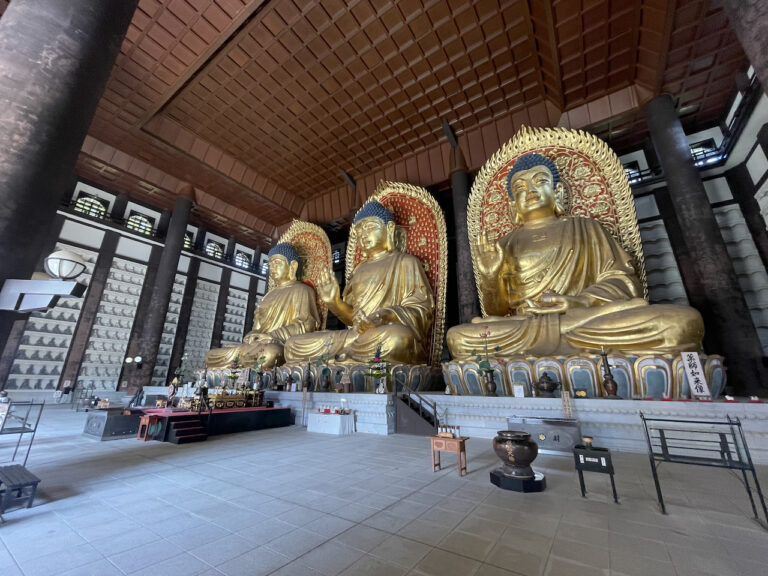Profile
If you’re looking to uncover some of Japan’s best-kept secrets, Chōraku-ji Temple 川会山 長楽寺 「但馬大仏」 in Hyōgo Prefecture should be on your list. Relatively unknown compared to temples in Kyoto or Nara, Chōraku-ji stands out with its grand Tajima Great Buddha (Daibutsu) statues, some of the tallest seated Buddha figures in the world. Its peaceful, off-the-beaten-path location makes it perfect for visitors wanting a unique cultural experience away from crowds.
A Bit of History
Chōraku-ji dates back to the Nara period (710–794 AD), with its origins rooted in Japan’s early temple-building era. Over the centuries, the temple has been rebuilt multiple times after facing fires and other natural challenges, giving it a layered historical character. Its current form came together in 1543, and more recently, it gained prominence with the addition of the incredible Tajima Daibutsu statues in 1994, which set it apart as a modern marvel amid Japan’s ancient temples.
The Tajima Daibutsu: A Trio of Giant Buddhas
The main attraction of Chōraku-ji is the Tajima Daibutsu, a trio of enormous Buddha statues that take centre stage in the Great Buddha Hall. These towering statues are crafted from camphor wood and adorned with gold leaf, making them visually stunning in addition to their sheer size.
- Shaka Nyorai (Shakyamuni Buddha) – Standing at an impressive 15.8 metres, this is one of the largest wooden seated Buddha statues in the world.
- Amida Nyorai (Amitābha Buddha) – Just slightly shorter, Amida Nyorai is 15.2 metres tall.
- Yakushi Nyorai (Medicine Buddha) – Also standing at 15.2 metres, this figure is equally awe-inspiring.
Each Buddha was created using a technique called yosegi-zukuri, where multiple wooden blocks are joined together, a practice that enables these statues to reach their incredible scale. The Buddhas were crafted with the help of over 20,000 skilled artisans and were transported to Chōraku-ji for assembly, where they were consecrated in a memorable ceremony in 1994. This addition has transformed the temple into a landmark of modern craftsmanship and devotion.
Architectural Highlights of Chōraku-ji
Beyond the giant Buddhas, the temple grounds are an architectural treat for visitors:
- Great Buddha Hall – Designed to house the statues, the hall itself is a marvel at 55 metres wide, 36 metres deep, and 40 metres tall.
- Five-Storey Pagoda – Rising 70 metres into the sky, this pagoda is the second tallest in Japan, and each floor contains various Buddhist statues.
- Main Gate (Daimon) – A striking entrance guarded by two Nio guardian statues, each 8 metres tall and weighing about 10 tonnes, which add an impressive touch to the approach.
- Bell Tower (Shōrō) – The only original structure left, the bell tower exudes a charm that reflects the temple’s history and the many stories it holds.
My Personal Take
While Chōraku-ji might lack the centuries-old status of Kyoto or Nara’s temples, I found it to be one of the most impressive temples I’ve ever visited in Japan. The Tajima Daibutsu statues, towering in silence within the spacious Great Buddha Hall, are breathtaking in both size and craftsmanship. The lack of heavy tourism and the location up in the mountains gives the temple an almost mystical quality that you rarely find in Japan’s more popular destinations.
Getting There
As it’s located in a remote area of Hyōgo Prefecture, Chōraku-ji is best accessed by car. This makes it a bit of a hidden gem, perfect for those looking to experience something unique and off-the-beaten-track. A visit to Chōraku-ji offers not just a view of incredible statues but a chance to feel the peace and grandeur that define Japan’s less-traveled treasures.
800 yen for adults, free for high school students and under
If you’re exploring Hyōgo, Chōraku-ji provides an experience you won’t easily forget — and for anyone interested in Japan’s architectural wonders, it’s an absolute must-see.
Map
Sorry, no records were found. Please adjust your search criteria and try again.
Sorry, unable to load the Maps API.












